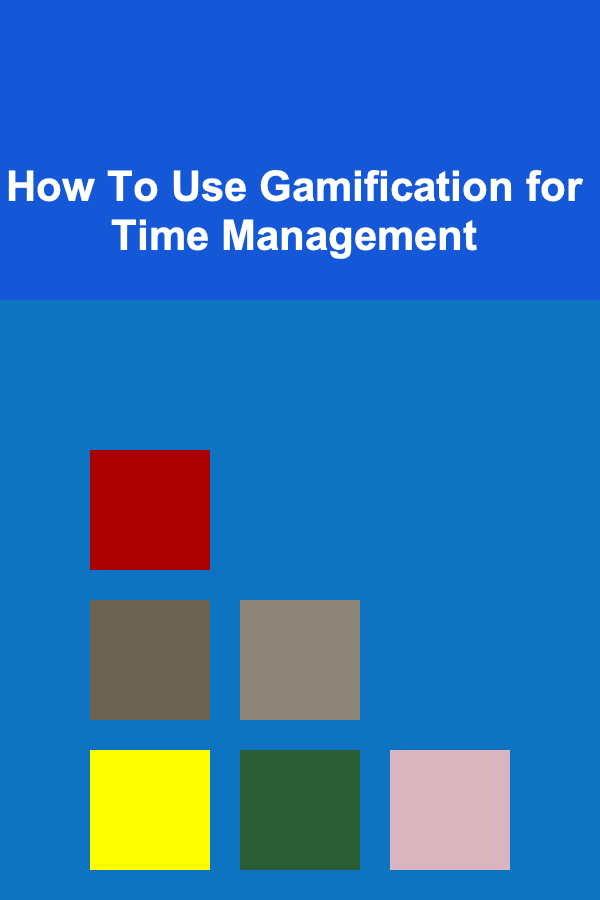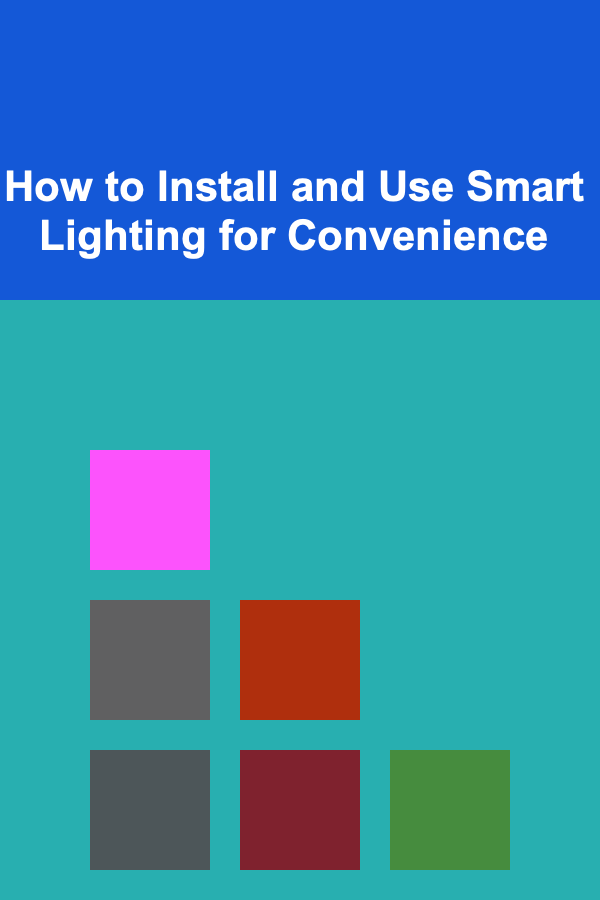
How To Use Gamification for Time Management
ebook include PDF & Audio bundle (Micro Guide)
$12.99$8.99
Limited Time Offer! Order within the next:

In today's fast-paced world, managing time effectively has become more crucial than ever before. With numerous distractions, overwhelming responsibilities, and endless to-do lists, staying on top of tasks can be incredibly challenging. Traditional time management techniques, such as to-do lists and schedules, often fall short in keeping us engaged and motivated over long periods. However, an emerging strategy that has gained significant attention in recent years is gamification---the application of game-design elements and principles in non-game contexts.
Incorporating gamification into time management can turn mundane, task-driven activities into engaging, motivating, and enjoyable experiences. By adopting game-like mechanics such as rewards, challenges, levels, and progress tracking, individuals can enhance productivity, improve focus, and cultivate better time-management habits. This article will explore how gamification can be used for time management, focusing on its principles, benefits, strategies, and real-life applications.
Understanding Gamification
What Is Gamification?
Gamification involves applying elements traditionally found in games---such as points, leaderboards, achievements, and badges---into everyday activities to make them more engaging and enjoyable. The goal is to increase motivation, enhance engagement, and foster desired behaviors by introducing game-like mechanics. While gamification is often used in marketing, education, and fitness, it has recently gained popularity in the realm of personal productivity and time management.
How Gamification Works
At its core, gamification taps into fundamental human psychology, particularly the desire for achievement, recognition, and progress. By introducing challenges , rewards , and feedback loops, gamification provides constant reinforcement that keeps individuals focused and motivated.
For instance, in a typical game, players are often given tasks or challenges to complete, and as they progress, they are rewarded with points, badges, or new levels. These rewards create a sense of accomplishment and push the player to keep going, enhancing their intrinsic motivation. The same principles can be applied to time management, where the objective is to break down tasks into manageable units, track progress, and reward oneself for completing these tasks.
The Benefits of Gamifying Time Management
1. Increased Motivation
One of the most significant benefits of gamification in time management is its ability to increase motivation. By transforming mundane tasks into challenges and rewarding achievements, gamification makes time management more engaging. The process of earning rewards---whether tangible or intangible---instantly boosts morale and motivates individuals to stay on track.
2. Better Focus and Engagement
Gamification also promotes sustained focus and engagement. Traditional time management methods, like simple to-do lists, often fail to maintain interest over extended periods. However, with the added elements of game mechanics, tasks become more dynamic. For example, by setting up a timer and racing against it to complete a task, or by earning badges for accomplishing specific milestones, individuals can maintain a heightened level of engagement and focus.
3. Improved Accountability
When incorporating gamification, individuals are often accountable not just to themselves but to others as well, especially if gamification is done in a social or competitive context. Whether it's through public leaderboards, sharing progress with friends, or engaging in collaborative challenges, there's a built-in sense of accountability that drives individuals to perform better.
4. Structured Workflow
Gamification encourages a structured workflow. By introducing levels, checkpoints, and reward systems, individuals are incentivized to break down their tasks into smaller, manageable units. This structure provides a clear roadmap to achieving long-term goals, turning overwhelming projects into a series of achievable milestones.
5. Enhanced Sense of Accomplishment
As players progress through a game, they feel a continuous sense of accomplishment, which is a key driver for motivation. The same feeling can be replicated in time management by setting and achieving small goals. The sense of accomplishment from completing one task often leads to the momentum needed to tackle the next one.
6. Healthy Competition
Gamification often involves an element of competition, either against oneself (in the form of personal bests) or against others (through public leaderboards). Competition can spark motivation, pushing individuals to work harder, faster, and more efficiently.
How to Implement Gamification in Time Management
1. Set Clear Goals and Objectives
Before gamifying your time management process, it's important to set clear and specific goals. Whether it's completing a work project, learning a new skill, or exercising more regularly, having a well-defined goal will help structure the game-like experience. Break the goal down into smaller, achievable tasks that can be completed incrementally.
2. Create a Point System
One of the most fundamental elements of gamification is the use of points. Create a point system where you assign points to different tasks based on their difficulty, duration, or importance. For instance:
- Easy tasks (e.g., checking emails, making phone calls): 5 points
- Medium tasks (e.g., completing a work report): 20 points
- Difficult tasks (e.g., presenting in a meeting, writing a proposal): 50 points
By tracking and accumulating points, you'll be able to visualize your progress and feel motivated to complete more tasks.
3. Introduce Levels and Badges
Levels and badges are another important element in gamification. Once you have accumulated enough points, you can "level up," which signifies your progress and achievement. Setting milestones (e.g., completing 10 tasks, earning 500 points) gives you short-term goals that push you to continue.
Badges serve as a reward for accomplishing specific tasks or reaching certain milestones. For example:
- Completing five tasks in one day: "Productivity Pro" badge
- Achieving 100% of your weekly goals: "Goal Crusher" badge
These rewards provide visual representation and acknowledgment of your achievements, further motivating you to keep going.
4. Track Progress with a Dashboard or App
To fully embrace the power of gamification, use a digital dashboard or app to track your progress. Numerous productivity apps incorporate gamification elements, such as Habitica , Forest , and Beeminder, which allow you to track tasks, earn points, level up, and set rewards. These apps provide feedback on your performance, helping you visualize your success and areas for improvement.
5. Create Time-based Challenges
Another powerful gamification technique is introducing time-based challenges. For instance, use a Pomodoro timer (25-minute work sessions followed by a 5-minute break) to create urgency and simulate a race against the clock. You can challenge yourself to complete as many tasks as possible within a set time frame or attempt to beat your previous time.
Alternatively, you could challenge yourself to "beat the clock" by setting strict time limits for each task. This approach works particularly well for tasks that are easy to procrastinate on, such as writing reports or responding to emails.
6. Add Social Elements and Competition
If you're more motivated by social engagement, gamification can be enhanced by introducing collaborative or competitive elements. Join productivity groups or invite friends and colleagues to participate in shared challenges. Many apps, such as Habitica and Streaks, allow for social interaction where you can compare progress, compete on leaderboards, or even complete challenges together. This added competition and peer accountability can drive you to work harder and accomplish more.
7. Reward Yourself
Gamification is not just about completing tasks for the sake of completing them. It's important to reward yourself when you achieve milestones. Rewards can be both intrinsic and extrinsic. For example, after completing a series of tasks or leveling up, treat yourself to something special:
- Take a short break
- Enjoy a favorite snack
- Watch an episode of your favorite show
- Go for a walk or engage in a hobby
These rewards create a positive reinforcement loop, helping to maintain motivation and momentum.
8. Review and Adjust Your System
To keep the gamification process fresh and engaging, regularly review and adjust your system. If you feel that your point system is no longer motivating you or that your tasks are not challenging enough, modify the levels, points, or rewards. Experiment with different formats to find what works best for you.
Real-Life Examples of Gamification in Time Management
Several companies and individuals have successfully incorporated gamification into their time management strategies. Here are a few examples:
1. Habitica
Habitica is a popular productivity app that uses a role-playing game (RPG) structure to gamify task management. Users create an avatar and earn points for completing tasks, which allows them to level up, unlock achievements, and gain rewards. Habitica turns the often mundane task of time management into a fun and immersive experience.
2. Beeminder
Beeminder combines gamification with financial accountability. Users set goals, and the app tracks progress toward these goals. If a user fails to meet their goal, they must pay a financial penalty. This creates a strong incentive to stay on track and complete tasks, gamifying the entire process with stakes and consequences.
3. Forest
Forest is an app that helps users stay focused by gamifying their time management. When you focus on a task, a tree grows in the app. If you check your phone, the tree dies. By gamifying focus, users are more likely to stay off distractions and concentrate on their work.
Conclusion
Gamification offers an innovative and effective way to manage time and increase productivity. By transforming mundane tasks into game-like experiences, individuals can stay motivated, focused, and engaged while achieving their goals. Whether through points, levels, rewards, or social competition, gamification adds an element of fun and excitement to time management, helping people to break free from procrastination and build better habits. By applying the principles of gamification, anyone can enhance their time management skills, increase their productivity, and create a more enjoyable work-life experience.

How to Build a Checklist for Event Sponsorship Outreach
Read More
How to Diversify Your Investment Portfolio for Maximum Returns
Read More
How to Install and Use Smart Lighting for Convenience
Read More
How to Organize Your Family Room for Movie Nights
Read More
How to Find Peace in the Mountains of Switzerland
Read More
How to Find New Artists in the Folk-Pop Scene
Read MoreOther Products

How to Build a Checklist for Event Sponsorship Outreach
Read More
How to Diversify Your Investment Portfolio for Maximum Returns
Read More
How to Install and Use Smart Lighting for Convenience
Read More
How to Organize Your Family Room for Movie Nights
Read More
How to Find Peace in the Mountains of Switzerland
Read More